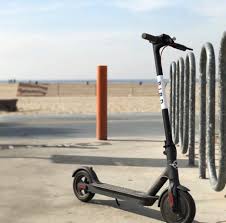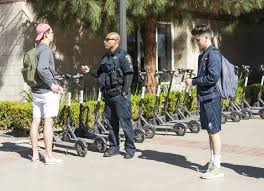If you are cruising the streets of San Diego these days, you are bound to see a new addition to the slew of “rideshare” options – an electric scooter. Bicycles and scooters have been getting people from point “A” to “B” and every where in between for years, and with technology rapidly evolving, it is no wonder tech has made its way into the simple world of two-wheeled urban transportation.
LimeBike (scooters and bikes), BIRD (scooters), Spin (scooters and bikes), and other companies venturing into the ride sharing business have recently launched their fleets of scooters and bicycles in and around San Diego. These modes of transportation are geared towards everyone, from the business person needing to get across town, to the tourist looking to explore the city.
Each bike or scooter is equipped with a company specific mechanism that locks or unlocks the bike and acts as GPS to keep track of the bike.
A user only needs to download the appropriate app, find the bicycle or scooter they want on the map, take a quick snapshot of the QR code, and away they go. You now have the ability to ride all across town without vehicle-intervention; but beyond that, what are your responsibilities?
Scooter Laws
According to the California Vehicle Code, a motorized scooter is any two-wheeled device that has handlebars, has a floorboard that is designed to be stood upon when riding, and is powered by an electric motor. See California Vehicle Code §407.5(a) After establishing you are riding a motorized scooter, the next question is, what laws do you have to abide by?
As an operator of a motorized scooter, you’re able to ride a scooter on a trail, bicycle path, or bikeway, and you are able to ride your scooter on roadways so long as the speed limit for the road is not over 25 mph and there is no designated bike lane. However, knowing where you are able to ride your scooter is only half the challenge. There are also laws that govern the operation of your scooter.
According to CVC §21235, a person operating a motorized scooter must:
- Wear a helmet (bicycle helmets are acceptable)
- Refrain from riding on the sidewalk
- Not have more than one user or rider at a time, and
- Possess a valid driver’s license (any class) or an instructional permit.
If there is a failure to abide by any of these laws, tickets may be issued.
Scooter Parking
Both scooter and bicycle users must follow the same restrictions on places they can park. A person operating either mode of transportation must park the vehicle out of the way of pedestrian traffic and neither one may be laid on the ground as a form of parking. Just like a person operating a scooter, if the laws are broken, tickets may be issued.
A notable difference between the bicycles and the scooters mentioned above is that a person operating a bicycle, electric or not, is not required to hold a driver’s license or an endorsement.
Renting a bike or scooter can be a very enjoyable experience and a unique way to venture around San Diego, but a ticket or injury may occur if the proper precautions are not taken. So grab that helmet, hop on, and enjoy America’s Finest City!
– –
This blog was written by Bonnici Law Group intern, Kevin Brenner. Kevin is a 3rd year law student at Thomas Jefferson School of Law who anticipates graduating in May 2018, and sitting for the July 2018 California Bar Exam. Thanks, Kevin!
Bonnici Law Group is San Diego’s bicycle law office, handing all things bicycle related. Have a question? Feel free to reach out for a free consultation.

Bicycle, Injury, and Disability Legal Team in in Westwood, CA
Westwood, CA, is a lively and diverse neighborhood located in the heart of Los Angeles.
Personal Injury in West Hollywood, CA
West Hollywood, California, is a vibrant and dynamic city in the heart of Los Angeles, renowned for its artistic flair, trendy boutiques, and world-class entertainment scene.




